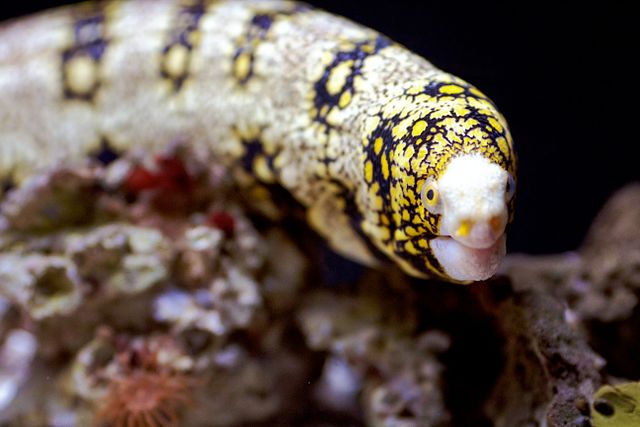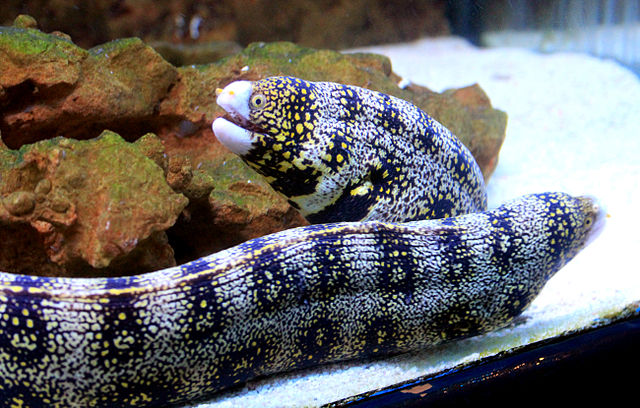Snowflake eels are carnivorous saltwater creatures, and while this might seem too dangerous for an aquarium, on the contrary – they’re great additions to your tank!
They are also known as snowflake morays, clouded morays, and starry morays.
Scientifically, they are known as Echidna nebulosa and are part of the Muraenidae family.

People keep morays all over the world, and they are a popular aquarium pet. They are the real eel deal! Worry not; they share few similarities with the electric eel, which is actually classified as a knifefish.
Interested in owning one of your own? Here is everything you need to know before buying a snowflake eel for yourself.
Snowflake Eel Appearance & Personality
Size and Effort
Snowflake eels are a medium-sized fish for the average aquarium setup. They are nocturnal predators, and strike at night.
Snowflake eels have been found in the wild at sizes past three feet, though in captivity, they usually reach two feet.
While domestic snowflake eels usually see a lifespan of four years or more, the proper setup can see your carnivorous fish reaching 10 to 15 years. Plan for the long haul with a snowflake eel in your tank!
They are native to the reefs of the Pacific Ocean, and range all the way from the east coast of Africa to Micronesia to Mexico and Central America. As snowflake eels are predators of the reef, other reef species should not be kept as pets in their tank.
Their coloration will vary depending on what area of the world they are from. Sometimes, they even change colour over the course of their life.

Usually, they have a white body with varying speckles of black. Some will have splashes of yellow underneath the black.
In the wild, they inhabit a depth of between seven and 100 feet. They prefer to dwell in the bottom of your tank.
It is notoriously difficult to distinguish a male from a female.
Price
You can expect to pay double to triple what you would for other more basic fish when looking to purchase a snowflake eel.
Depending on size, snowflake eels can cost anywhere from $35.00 for a smaller eel to $80.00 for an extra-large eel.
Tankmates
If you are housing these carnivorous eels with other fish, there are several factors to keep in mind.
These fish should not be small enough to fit inside of a snowflake eel’s mouth, as any fish who is will register as nothing more than a tasty treat to them.
Snowflake eels have been known to fight amongst their own, to the death, even in large aquarium setups. Their preferred domestic lifestyle is a solitary one.
A close eye should be kept on any fish being added in with snowflake eels, and knowing how aggressive your particular snowflake eel is will be the second largest factor in how good a tankmate they might make.
The most important factor is how well-fed your eel is, as their most predatory tendencies will inevitably come out if they are allowed to get too hungry.
Snowflake eels should not be kept in the same tank as shrimp, other crustaceans, or any other reef dwelling aquatic creatures that you are keeping as pets, because they are the natural prey of the snowflake eel. This includes lobsters.
Health Problems
Like all eels, snowflake eels do not have scales, and instead secrete a thick coating of mucus around their bodies for protection.
This makes them extremely sensitive to aquarium medications, so these medications should be avoided for them where possible.
If your snowflake eel appears to be developing an infection, a series of water changes is in order.
You may also need to employ a chemical filter media to remove any water impurities that could be making your eel sick.
With the right diet and proper tank care, snowflake eels can be hardy, hearty fish to keep.
Breeding
Breeding snowflake eels in captivity is not easy.
Long time eel keepers find it to be a mysterious endeavour, in part because the sex of a snowflake eel is not distinguishable to the human eye.
Snowflake eels also often do not do well together in the same tank, making breeding harder to accomplish.
Snowflake Eel care
Tank Requirements
Snowflake eels require a tightly sealed saltwater tank setup of at least 55 gallons (or 208 liters). Some eel keepers recommend a tank minimum of at least 75 gallons (or 284 liters) for an optimal life.
Like other eels and long, slippery fish, they are notorious for escaping and sliding into places they are not meant to go. Water filters especially need to be tightly sealed to avoid harm coming to your snowflake eels.
They are coral reef dwellers, and require a good amount of live rock in their tank to do well.
Live rock is porous limestone that has spent time on the ocean floor and has become populated with ocean life such as beneficial microbes, amphipods and copepods, sea stars, coral, and algae.
It performs many essential functions in a marine tank, including filtration, nitrate reduction, and providing a hiding place for your fish.
Water Requirements
The snowflake eel prefers its water to be 72 to 78 degrees Fahrenheit (or 22.22 to 25.55 degrees Celsius) in temperature.
The water hardness (dKH) should be between 8 and 12 degrees, and the salinity should be between 1.020 and 1.025. The pH level should be kept between 8.1 and 8.4.
Tank Set-Up
Your snowflake eel will need to have at least three cave-like areas to hide in. These should include rocky caves, and can also include PVC pipes or other tank decorations.
If your eel has sufficient cover areas to hide in, he or she will feel more comfortable in your tank and you will see him or her more.
Although snowflake eels eat at night, if there is enough live rock for your eel’s comfort, you will be able to see him or her during the day.
A common eel behaviour is to hide in a cave or crevice with only the head sticking out, and to rhythmically sway the body. Make sure to provide areas where your snowflake eel can engage in this natural behaviour.
Your snowflake eel will be very good at toppling and rearranging rock-work, so make sure that any stacked rocks are securely fastened in place with zip ties or epoxy.
Tank Maintenance
Maintaining the tank to keep the water clean is very important for a snowflake eel’s health. If you notice your eel developing an infection, the water quality is often to blame.
Water changes need to be performed consistently to keep your tank in good shape.
As they can make a mess of their tanks in fairly short order due to their carnivorous needs, water filtration systems are important to consider. A protein skimmer will go a long way toward your eel’s quality of life.
Acclimating Them to Your Tank
Introducing them to the tank is easy, as long as you follow some simple steps.
First, place the bag they were packaged in from the pet store into your tank for 15 minutes so that the water reaches the same temperature as your tank.
Next, cut open the bag just below the clip and fold the top edge of the bag down one inch (or 2.54 centimetres) to create an air pocket, so that the bag floats easily.
After this, add a half cup (about 100 millilitres) of your tank water to the bag every four minutes until the bag is full.
Discard half the water from the bag, then again add a half cup of your tank water every four minutes to fill the bag again.

At this point, you can take your eel out of the bag using your net and release him or her into the tank. Now, discard the bag and the water in it. Do not mix the bag water with your tank water.
Snowflake eels will likely be skittish when first introduced to a new tank, and may hide for the first few days. If you consistently offer food to them every night, they will eventually come out and eat it.
With the proper coverage and meeting of their needs, snowflake eels tend to be a visible, proud fish.
Snowflake Eel Food And Diet
As snowflake eels are strictly carnivorous, their diet will need either live or frozen prey.
They respond well to shrimp, calamari, silversides, shellfish like mussels and crabs, or anything that they can fit in their mouth and has a lot of meat to it.
They do not respond as well to freshwater fish, as they are not the prey that they are acclimated to; feeding them some freshwater fish, such as goldfish and rosy red fish, can even cause liver disease.
If their diet is primarily frozen rather than fresh, a vitamin soak routine is recommended.
Some snowflake eels can be taught to eat from your hand, but it is not a venture to undertake uninformed: they can be moderately aggressive and have been known to take chunks of flesh. These fish have teeth!
If the snowflake eel is racing toward your hand, it is best for your safety to remove your hand. Their bites can easily become infected, and even a snowflake eel who has been docile for years can change his or her mind about taking a bite or not.
When in doubt, it is safest to feed them with tongs.
Snowflake eels generally eat at least every two weeks, though their dietary tendencies will vary during less active spells.
Since they are nocturnal predators, feeding them at lights-out time is advised. This will distract them from trying to feed on your other fish who are sleeping.
Here’s a video showing a snowflake eel during feeding time.
Snowflake Eel Conclusion
The snowflake eel makes a good first eel for a marine fish keeper.
If you provide it with enough hiding places and a healthy diet, its antics will delight you for years to come.
Do you plan on adding any Snowflake Eels to your tank?



